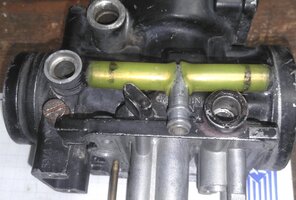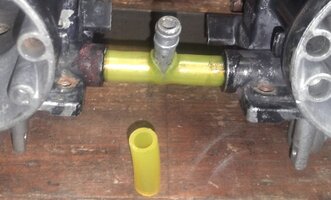No. Biltwell specializes in motorcycle parts. It’s strange that this happened. Hopefully Revzilla will make it right.
-
Enjoy XS650.com? Consider making a donation to help support the site.
XS650.com receives a small share of sales from some links on this page, but direct donations have a much greater impact on keeping this site going.
You are using an out of date browser. It may not display this or other websites correctly.
You should upgrade or use an alternative browser.
You should upgrade or use an alternative browser.
Finding my standard...
- Thread starter willis
- Start date
Good news! Revzilla has already responded and is shipping out a replacement set. All I had to do was provide a picture showing the ID of both grips were the same. Great customer service right there.

Now that is a nice update to hear. 
Those short term unexpected troubles do delay a guy sometimes. No worries though, the best XS things come along with patience as you already know by now. Your bike is a real looker already and will only improve!
-R
Those short term unexpected troubles do delay a guy sometimes. No worries though, the best XS things come along with patience as you already know by now. Your bike is a real looker already and will only improve!
-R
That’s good to hear , I have also returned merchandise to Revzilla before, their customer service is excellent.
WOW... dusting off the mothballs on this one. I can't believe is been 2 1/2 years since my last post on the '75. Yesterday I broke it out of deep storage and gave it a bath. I only rode it one time last year that I can remember, but I stored it properly and everything looked good. I put a new battery in it and threw in some gas and... it started leaking right away from the left petcock. Fortunately I have a spare set of new petcocks in the parts stash. But, the new one leaked too. I think the o-rings were just dry, as the leak seems to have subsided by the time I put it back away.
But the bike fired right up and idled pretty decent at 1100 rmp. But I had forgotten that I had a miss on the right cylinder at idle. As soon as I give it a little gas it would pick back up. The carbs are very clean and were drained before I stored it. My initial thought is that the float height might be off. I've got the clear tube tool I can screw into the float bowl to check, but it was pretty close the last time I checked. The only other thing I haven't done yet is check the synchronization of the two carbs. Any thoughts on if I am looking in the right direction to fix this miss?
But the bike fired right up and idled pretty decent at 1100 rmp. But I had forgotten that I had a miss on the right cylinder at idle. As soon as I give it a little gas it would pick back up. The carbs are very clean and were drained before I stored it. My initial thought is that the float height might be off. I've got the clear tube tool I can screw into the float bowl to check, but it was pretty close the last time I checked. The only other thing I haven't done yet is check the synchronization of the two carbs. Any thoughts on if I am looking in the right direction to fix this miss?
yes do a sync, then get both idle mix AND stop screws at about the same place.
This reminds me of the early days of my US Air Force 20 year career. My first base was in Anchorage Alaska and we had many, many different airframes there...Fighters, Trainers, Helicopters, AWACS, Cargos, etc.I think the o-rings were just dry, as the leak seems to have subsided by the time I put it back away.
We frequently would get dispatched out to C-130's venting fuel from all of the fuel tanks at one time....as soon as I heard that I would ask Job Control to have several fuel bowsers (catch tanks for waste fuel) sent out to the hard stand while I was gathering my tech data and tools to respond to the aircraft.
First question I'd ask the Crew Chief when I got to the aircraft "Did this bird just come out of Phase Maintenance?". Their answer was always a resounding "Yes".
We'd then place the fuel bowsers under the vent outlets and let it dribble/pour away while monitoring it. The Crew Chief in a panic would always ask "Aren't you going to do anything?!!".
I'd tell em..."Just give it a few, it'll stop". Sure enough, like clock work it would get less and less until it came to a complete stop.
I explained to him that the seals all shrink when the aircraft sits in deep maintenance "Phase" for weeks with no fuel in the system....they need to get wet and swell back up to do their job.
Worked like magic every time.
Whenever I take a fuel valve apart, the rubber bits get a coat of Parker OLUBE. It's the ticket.
The fuel tee on BS34's is like that. They always leak after sitting dry, add fuel, wait a day or so and tight as a drum.This reminds me of the early days of my US Air Force 20 year career. My first base was in Anchorage Alaska and we had many, many different airframes there...Fighters, Trainers, Helicopters, AWACS, Cargos, etc.
We frequently would get dispatched out to C-130's venting fuel from all of the fuel tanks at one time....as soon as I heard that I would ask Job Control to have several fuel bowsers (catch tanks for waste fuel) sent out to the hard stand while I was gathering my tech data and tools to respond to the aircraft.
First question I'd ask the Crew Chief when I got to the aircraft "Did this bird just come out of Phase Maintenance?". Their answer was always a resounding "Yes".
We'd then place the fuel bowsers under the vent outlets and let it dribble/pour away while monitoring it. The Crew Chief in a panic would always ask "Aren't you going to do anything?!!".
I'd tell em..."Just give it a few, it'll stop". Sure enough, like clock work it would get less and less until it came to a complete stop.
I explained to him that the seals all shrink when the aircraft sits in deep maintenance "Phase" for weeks with no fuel in the system....they need to get wet and swell back up to do their job.
Worked like magic every time.
well if they are really far gone the plastic cracks, then:


Yup - Parker O-Lube is good stuff and I also use Hylomar Blue from Rolls-Royce. It is usually avcailable online or from airport mechanic supply houses.View attachment 243514
Whenever I take a fuel valve apart, the rubber bits get a coat of Parker OLUBE. It's the ticket.
The leak has subsided. I checked it last night when I was out in the shed. Now to find time for the carb synch. Since I am not very experienced in the carb synching, I will likely use the dead cylinder method. I'll just be sure to ground out the plug wire since I've got a Pamco unit installed.
Since I am not very experienced in the carb synching, I will likely use the dead cylinder method.
You’ve got BS38’s don’t you? They have vacuum ports built in, you should consider buying or making a manometer. Takes the guesswork out of it.
75's do not have the vacuum ports and are not linked. I don't think they started the vacuum ports until 77 IIRC.
Similar threads
- Replies
- 22
- Views
- 505
